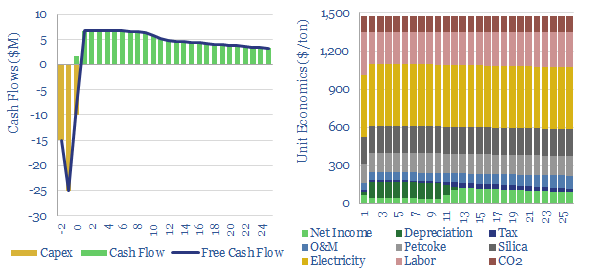This data-file captures silicon carbide production costs: spanning from materials grade SiC ($1,500/ton marginal cost, 5 tons/ton CO2 intensity) through to SiC wafers that are used in the electronics industry ($30M/ton marginal cost, 200 tons/ton CO2 intensity). SiC semiconductor remains one of the most opaque and hard-to-guess value chains we have looked at in our economic models.
Silicon carbide material is one of the hardest crystalline composites known to mankind, with an enormously high melting point of 2,700°C and very high chemical resistivity. Hence it is used in the steel/metals industry, aerospace, brake pads of high-end automobiles and bullet proof vests.
Silicon carbide material is made by super-heating high-grade silica (SiO2) with petcoke (C) in electric furnaces over 3-10 days. A 10% IRR might require a silicon carbide price of $1,500/ton. CO2 intensity is 5 tons/ton, of which approximately half is direct emissions from producing CO2, and the other 50% comes via 6MWH/ton of electricity use.
Silicon carbide can also be made into semiconductor wafers, underpinning MOSFETs with low resistances, high switching frequencies, and increasing application in practically all new energies (note here).
However, measuring the price of SiC MOSFETs in terms of the cost per kg of SiC is a bit like measuring the price of Michelangelo’s David in terms of the cost per kg of marble. The value is not really in the material, but the very precise way it is arranged. And the ‘price’ is equally ineffable.
A 200mm SiC wafer might cost $1,500 to produce and weigh 50-grams, yielding an effective cost of $30M/ton of SiC contained, or $10M/ton of SiC consumed (assuming 2/3 material losses during formation/wafering).
Likewise, a large SiC fab producing 30,000 wafers per month might only use about 50 tons of SiC per year, in the production of 20 tons per year of wafers. So equally, a $1bn capex cost for such a facility equates to around $20M/Tpa, which is one of the highest numbers in any economic model we have ever constructed.
What underpins the exceptionally high costs is that forming SiC crystals from vaporized and highly purified SiC via the Lely Process at 2,000ºC proceeds at a rate of 100-300μm per hour. This is 1,000x longer than forming mono-crystalline poly-silicon from liquid silicon via the Czochralski method at 1,425ºC and at 25-100mm/hour. Thus a very large plant is required for SiC wafer production. Building and maintaining the plant seems to dominate the overall SiC wafer production costs.
Some sources say that the cost difference between silicon and SiC is about 15x (TSE data here), culminating in a 4x difference between resultant MOSFETs. But this is for 150mm wafers. It is inherently more difficult to form larger SiC wafers, and as we have modelled a 200mm wafer facility, our cost delta comes out at 20-40x on a $/kg basis.
The CO2 intensity (in kg/kg) embedded in SiC wafers might thus run to around 200 kg/kg. However, numbers remain uncertain.
Compared to other value chains that we have explored in our economic models, silicon carbide production costs remain more opaque and the numbers in this data-file are more like guesses (unsatisfyingly), versus the detailed cost breakdowns that we would usually look for in our modelling work. For now, this model is a placeholder, and we will look to gather more data breaking down production costs in semiconductors.
